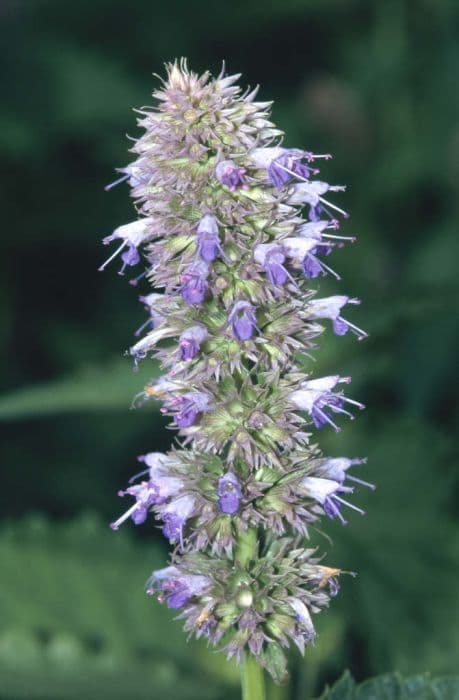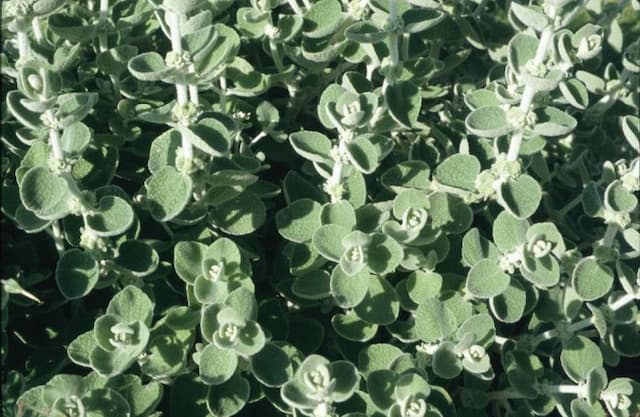Catmint Nepeta racemosa 'Little Titch'

ABOUT
The plant Nepeta racemosa 'Little Titch', more widely known as 'Little Titch' Catmint, is a compact and floriferous perennial that showcases a bounty of lavender-blue flowers. These blooms are held in abundant, spiky inflorescences that rise above the foliage, creating a lively display. The grey-green leaves are small and aromatic, with a slightly heart-shaped appearance and delicate saw-toothed edges that lend a fine texture to the overall look of the plant. 'Little Titch' Catmint is visually attractive with its rounded and mounded form, and its flowering season adds a long-lasting pop of color to any garden bed or border. The plant is also favored for its ability to attract pollinators such as bees and butterflies, thanks to its nectar-rich flowers. The foliage remains neat and attractive even when the plant is not in bloom, making it a versatile choice for a variety of garden settings.
About this plant
 Names
NamesFamily
Lamiaceae.
Synonyms
Dwarf Catmint, Little Titch Catmint.
Common names
Nepeta racemosa 'Little Titch'.
 Toxicity
ToxicityTo humans
Cats Catnip is not known to be toxic to humans, and there's generally no cause for concern if a small amount is accidentally ingested. Consumption of large quantities is not advised due to the lack of information on its potential effects on humans, but it isn't considered to harbor significant toxicity. Therefore, no specific symptoms of poisoning are expected upon ingesting parts of the Catmint plant.
To pets
Cats Catmint is widely recognized for its behavioral effects on cats. The plant is not toxic to cats or dogs, and cats may exhibit reactions such as sniffing, rubbing against, rolling over, and eventually may consume parts of the plant. These responses are due to the presence of nepetalactone, a compound that affects felines, typically inducing a temporary state of euphoria. Consumption of Catmint is not harmful to cats and should not result in poisoning. However, ingestion in large amounts might cause mild gastrointestinal upset, including vomiting or diarrhea, but serious toxicity is not expected.
 Characteristics
CharacteristicsLife cycle
Perennials
Foliage type
Deciduous
Color of leaves
Green
Flower color
Blue
Height
1 foot (30 cm)
Spread
1 foot (30 cm)
Plant type
Herb
Hardiness zones
4
Native area
Eurasia
Benefits
 General Benefits
General Benefits- Compact Size: 'Little Titch' is a dwarf variety that fits well into small gardens or spaces.
- Drought Tolerant: Once established, it is quite drought-resistant and requires minimal watering.
- Low Maintenance: This plant requires little care beyond occasional watering and pruning to maintain shape.
- Attracts Pollinators: Bees and butterflies are attracted to the flowers, helping to pollinate nearby plants.
- Deer Resistant: The aromatic foliage of this plant is generally not favored by deer, reducing garden damage.
- Fragrant Flowers: The plant produces aromatic blooms that can add pleasant scents to the garden setting.
- Long Blooming: 'Little Titch' has a long blooming period, providing extended color and interest throughout the growing season.
- Versatile Use: Ideal for rock gardens, borders, or as ground cover due to its compact growth habit.
 Medical Properties
Medical Properties- Antiseptic: Nepeta racemosa, commonly known as Catmint, may contain compounds with antiseptic properties that can help in preventing infections.
- Anti-inflammatory: Catmint might have anti-inflammatory effects that could be beneficial in reducing swelling and irritation.
- Sedative: This plant is sometimes attributed with mild sedative effects, potentially aiding in relaxation and sleep.
- Antispasmodic: There may be antispasmodic components in Catmint that could help in alleviating symptoms of muscle spasms or cramps.
- Diaphoretic: Catmint has been used as a diaphoretic, which means it may promote sweating and potentially help in reducing fevers.
- Carminative: The plant may have carminative properties, aiding in the relief of flatulence or gas in the digestive tract.
 Air-purifying Qualities
Air-purifying QualitiesThis plant is not specifically known for air purifying qualities.
 Other Uses
Other Uses- Nepeta 'Little Titch' can be used to create a low-growing fragrant carpet in fairy gardens, which are miniature gardens designed with small-scale plants and decorations.
- This plant is suitable for planting between stepping stones or pavers, as it can tolerate light foot traffic and releases a pleasant aroma when brushed against.
- 'Little Titch' can be implemented into xeriscaping designs, a landscaping method that reduces or eliminates the need for supplemental water from irrigation.
- In culinary uses, leaves of Catmint can be used as a mild flavoring agent similar to mint in teas and salads, although not as common as other mint family herbs.
- The dried leaves of 'Little Titch' can be used to fill cat toys, as the scent is attractive to cats much like other members of the Nepeta genus.
- When planting, 'Little Titch' can be used as a natural pest repellent in gardens due to its ability to deter certain insects.
- Its compact growth and lavender-blue flowers make it an attractive option for bonsai gardens where it provides a contrast in foliage and color.
- The plant can be implemented as a living mulch, helping to retain soil moisture and suppress weeds due to its dense growth habit.
- 'Little Titch' can be used in cut flower arrangements or bouquets for its delicate flowers and interesting foliage, although it does not have a very long vase life.
- It can serve as a placeholder plant in a garden design, quickly filling in gaps while slower-growing perennials establish themselves.
Interesting Facts
 Feng Shui
Feng ShuiThe plant Catmint is not used in Feng Shui practice.
 Zodiac Sign Compitability
Zodiac Sign CompitabilityCatmint is not used in astrology practice.
 Plant Symbolism
Plant Symbolism- Relaxation: Nepeta racemosa 'Little Titch', commonly known as Catmint, often symbolizes relaxation due to its calming effect on cats and sometimes even on humans, in a similar way to its relative, catnip.
- Playfulness: As the plant is famously loved by cats who exhibit playful behaviors around it, Catmint can represent playfulness and joy.
- Affection: Given how cats are drawn to the plant, Catmint can imply affection and companionship, reflecting the bond between pets and their owners.
- Home Comfort: Catmint with its ability to attract felines and its use in gardens, may symbolize domestic comfort and the creation of a cozy, welcoming home environment.
 Water
WaterCatmint 'Little Titch' should be watered thoroughly, allowing the top inch of the soil to dry out before the next watering. Typically, this means watering the plant every 1 to 2 weeks, depending on the climate and season, with more frequent watering required in hot, dry periods. An average watering routine would involve providing the plant with approximately 1 to 1.5 gallons of water every week during the active growing season, with adjustments made for rainfall and temperature variations. During the winter, watering should be reduced to match the plant's dormant stage and lower evapotranspiration rates.
 Light
LightCatmint 'Little Titch' thrives best in full sun conditions but it can also tolerate partial shade. The ideal spot for this plant would be in an area that receives at least 6 to 8 hours of direct sunlight daily. However, if you're in an extremely hot climate, providing afternoon shade can help protect the plant from excessive heat.
 Temperature
TemperatureCatmint 'Little Titch' prefers temperate climates and does well in temperatures ranging from 50 to 86 degrees Fahrenheit. The plant can survive occasional dips below this range, but temperatures below 50 degrees Fahrenheit might slow its growth. Ideal growth occurs within the upper half of this temperature range, providing robust foliage and flowers.
 Pruning
PruningPruning Catmint 'Little Titch' encourages a more compact growth habit and promotes additional blooms. It is best to prune the plant in early spring to stimulate new growth and again after the first flush of flowers has faded to encourage a second bloom. Typically, cutting back by a third is sufficient, and this should be done every few years to maintain the plant's vitality.
 Cleaning
CleaningAs needed
 Soil
SoilCatmint 'Little Titch' thrives best in well-draining soil with a pH range of 6.0 to 7.5. A mix of loamy garden soil, peat, and perlite or sand can provide the right texture and nutrient balance. Amend with compost for added fertility and ensure the soil is not too heavy or clay-rich to prevent waterlogging.
 Repotting
RepottingCatmint 'Little Titch' should be repotted every 2-3 years to refresh the soil and provide space for growth. If the plant appears to be overly root-bound or if the growth seems stunted, it may need more frequent repotting.
 Humidity & Misting
Humidity & MistingCatmint 'Little Titch' is adaptable and does not require high humidity; average room humidity is typically sufficient. It prefers drier conditions and can handle the lower humidity levels common in most homes.
 Suitable locations
Suitable locationsIndoor
Place Catmint 'Little Titch' near a sunny window and ensure good airflow.
Outdoor
Full sun to part shade; protect from extreme heat and enrich soil.
Hardiness zone
3-8 USDA
 Life cycle
Life cycleThe plant commonly known as 'Little Titch' Catmint (Nepeta racemosa 'Little Titch') starts its life cycle with seed germination, occurring in ideal conditions of warm temperature and moist soil. Following germination, seedlings establish themselves and develop into young plants with characteristic green, aromatic foliage. The vegetative growth stage sees the plant developing a compact, mounded habit with dense, fine-textured leaves. As it matures, Catmint 'Little Titch' enters the flowering stage in late spring to early summer, producing small, lavender-blue flowers that attract bees and butterflies. After pollination, the flowers give way to fruit that contain seeds, completing the reproductive cycle. The plant may go dormant in the winter, depending on the climate, but typically resumes growth in spring from the same root system (perennial habit), or new seeds may germinate to continue the cycle.
 Propogation
PropogationPropogation time
Early Spring
Propogation: For Nepeta racemosa 'Little Titch', commonly known as Catmint, the most popular method of propagation is through stem cuttings. This technique is typically undertaken during the late spring or early summer months. To propagate, one should select healthy, non-flowering stems and cut 2 to 3 inches (approximately 5 to 7.5 centimeters) just below a node. The lower leaves of the cuttings should be removed and the base dipped into a rooting hormone to enhance root development. The stems should then be placed in a well-draining soil mix and kept moist. Cuttings should be kept in indirect light until roots have established, after which they can be transplanted to their desired location in the garden.









